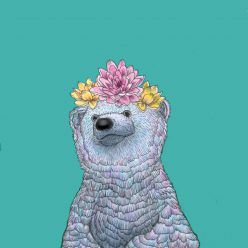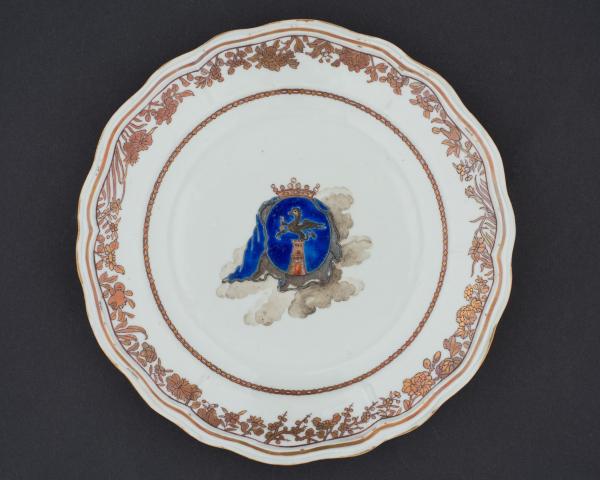Plate with the Arms of the Gyllenborg Family
Material(s): Porcelain
Origin(s): China around 1755
From all the ceramics and porcelain wares found in the Trade Gallery in ACM, these Armorial porcelain plates caught my attention. Although small in size, the Gyllenborg coat of arms were painted with such attentiveness, capturing the intricate designs of the arms and borders. The elaborate border contrasts against the somewhat simple family crest yet the gold from the gilding accentuates and complements the vivid deep blue colour of the crest. Thus, the highly detailed painting emanates an aureate element to the plate.
The gilt border uses vegetal forms such as flowers and leaves which come in many variations or perhaps different species native to Sweden. This border encircles an enamelled centre which features a family’s coat of arms. The crest features a golden crown resting atop a vivid deep blue oval suggesting nobility. Within the oval lies a miniature turret with a dark, winged creature posing on top of it. The creature has spikes on its back and claws arching outwards. Enveloping the blue oval, a dark greyish border along with some blue on the left are draped around it. Also, smoky greyish clouds are illustrated surrounding the crest’s bottom and left.
The floral inspired design of the gilt border can be seen in the form or shape of the plate whereby the edges of the plate is curved in an inconsistent yet symmetrical manner. The edges bend and curves in a specific pattern to create and ornate, attention to detail aesthetic.


I agree with what Emma has said. Although the border is quite elaborated, but the family crest still stands out because of the choice of colour for it, and placement. It is interesting to see how the ceramics technique (plate with painting/motifs) that are originally from China, are valued, and evolved according to its time and target audience. In this case, a Swedish family. It is probably ordered by a Swedish family, and then passed down from generations to generations as a heirloom.
Thanks Alyssa for your interesting feedback–you bring up an interesting point about the contrast in colors and how color and composition makes the family crest stand out more than the intricate gold border. Perhaps the border helps focus our eyes?
Emma, I wonder if we can build on Alyssa’s point for your team’s overall project–the function of color in each of the ceramics?
Sorry for the late reply Sujatha, but yea sure we will look into it!